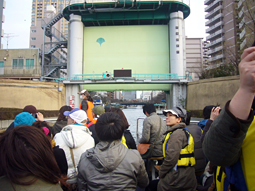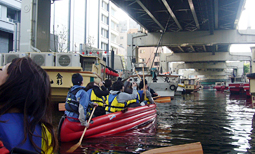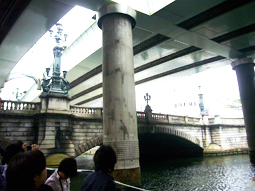 |
|
Here and There introduces art, artists, galleries and museums around Japan that non-Japanese readers and first-time visitors may find of particular interest. The writer claims no art expertise, just a subjective viewpoint acquired over many years' residence in Japan.
|
|
 |
|
|
 |
 |
All Aboard: Life on the Water with the Boat People/Tokyo Artpoint Project
Alan Gleason |
 |
 |
|
 |
| Low bridge, everybody down: a Boat People cruise enters a floodgate into eastern Tokyo's maze of canals. |
|
Boat People director Genichi Ide provides running commentary as the Central East Tokyo cruise passes under Tokiwabashi, the city's oldest bridge. |
Tokyo and Yokohama are relatively young cities. Their downtown and harbor districts were built on land reclaimed from Tokyo Bay over the past four centuries, dating back to when the Tokugawa Shogunate created a new capital, Edo, out of swampland. Edo's successor, Tokyo, still boasts a labyrinthine network of canals rivaling Venice. Yet because these waterways (those that have not been paved over) lie mostly in grubby industrial districts -- literally the backwaters of the city -- they have never been treated as a cultural asset, much less a tour destination.
Nowadays, however, the tide may be turning, so to speak. As artists flee overpriced downtown neighborhoods like the toney Ginza (Tokyo's traditional gallery row), they have gravitated to the warehouses that stand on the fringes of the bay in Tokyo and Yokohama, or along Tokyo's Sumida River and the canals that form a grid across much of the city's east side. Today some of Japan's biggest movers and shakers in the contemporary art scene occupy industrial-sized spaces by the Sumida, still walking distance from the Ginza but far cheaper -- and worlds funkier. (See my earlier article about the Maruhachi Warehouse in Here and There.) It's the Tokyo equivalent of moving from Manhattan across the East River to Williamsburg, or across the Hudson to Hoboken.
The migration of artists and other creative types to the water is paralleled by growing interest among other citizens who find in these unsung corners of the megalopolis a number of virtues: the views, the nuggets of historical and architectural significance, the perspective on urban and environmental issues from a fresh angle. Lately, water wonks and artists have formed a symbiotic relationship in which creativity is inspired by, and in turn inspires, greater attention to Tokyo and Yokohama's aquatic neighborhoods. The result is a growing number of collaborative programs like the boats-'n'-art tours organized by the Boat People Association and the Tokyo Artpoint Project.
Boat People's membership consists, not of refugees, but professionals -- artists, architects and city planners -- intrigued by the "urban waterscape" around Tokyo Bay. Their objective is to get as many residents as possible to experience the waterfront firsthand so they too can appreciate the rapid changes the harbors and rivers have undergone and are still undergoing, as well as their untapped potential.
One of Boat People's auxiliary interests is learning how to cut through the maze of bureaucratic red tape that covers the waterfront and discourages creative uses of it. The group's founder, Genichi Ide, ran this gauntlet himself when Life on Board, a bar/lounge he set up on a barge in Shinagawa, was shut down by the Tokyo Metropolitan Government. Since launching Boat People in 2004, Ide and his merry crew of volunteers have pursued an eclectic and ever-expanding agenda of "cruising events, art events, symposiums, renovations of barge ships, and parties."
Boat People's interests happen to dovetail nicely with those of another group, Tokyo Artpoint Project, whose stated aim is to create "artpoints" around the city that will "generate the greater cultural power of Tokyo." Their "fields of action" include closed-down schools, idle land, and linear avenues of transport conducive to linking a number of such "points": streets, train lines, and of course waterways.
Part of the government-funded Tokyo Culture Creation Project, Artpoint is a relative newcomer to the local scene, but it has successfully teamed up with entities like the Tokyo Art School, Arts Initiative Tokyo, and Tokyo Art Beat to develop a vigorous program of training courses, tours, lectures and other events over the past two years.
Artpoint and Boat People first joined forces in the summer of 2009 with "Life on Board@CET." CET stands for Central East Tokyo, a new monicker for the warehouse-cum-gallery/studio district wedged between downtown and the Sumida. The neighborhood was a perfect place for the two groups to work together: an up-and-coming but still under-the-radar mecca of contemporary art, CET is criss-crossed by canals. Participants in the July event boarded small barges at Tokiwabashi, Tokyo's oldest bridge, to cruise downstream under the legendary Nihonbashi (itself now crammed beneath an expressway), through a lock into a narrow side canal, past the rear windows of studios and the decks of waterside cafes, and finally out to the tidal waters of the Sumida, just upstream from where it enters Tokyo Bay. On board, a Boat People guide provided maps and commentary on the history of the bridges, canals, and neighborhoods. Disembarking passengers then followed the maps on a walking tour of local galleries.
This past March, the two groups teamed up again to offer a series of tours focusing on the urban planning aspects of the Tokyo waterfront, highlighting projects that date back to the Shogunate. While one boatload circumnavigated the Hama Detached Palace -- a vast bayside expanse of formal gardens surrounded by a moat -- another group transferred to small rubber dinghies, which they rowed themselves up the tiny Shibuya River deep into central Tokyo. Decrepit boathouses and the makeshift dwellings of street people perched precariously atop the Edo-era stonework that still lines the steep banks of the channel. Bullet trains and monorails roared by overhead, while cars and trucks crawled through one of Tokyo's busiest expressway interchanges. People waved bemusedly from the bridges as we passed under them. Though the city has done much to clean up its canals in recent years, less than pleasant odors of unknown origin still wafted up at odd intervals en route.
It was actually a bit claustrophobic on the Shibuya, and a relief to return to the wide open waters of Tokyo Bay, from which a boat's-eye-view offered unparalleled panoramas of nonstop architectural drama: cutting-edge all-glass highrises, rows of giant container cranes, rusting warehouses (some converted to trendy restaurants and watering holes), and the occasional funky old tugboat moored against a tottering pier with a lone wooden shack that one could swear was abandoned -- were it not for the colorful futon hanging out the window for airing on a sunny spring day.
To sign up for Boat People's email announcements of upcoming water tours of Tokyo and Yokohama, click on "Mail Subscription" on the website below.
 |
|
 |
| Intrepid boaters row their rubber dinghies up the narrow Shibuya River, past a flotilla of yakatabune pleasure boats parked under the Tokyo Metropolitan Expressway. |
|
Hemmed in by office buildings, an old wooden boathouse clings tenaciously to the side of a downtown canal. |
|
 |
|
 |
| Silent in the late afternoon after yet another busy morning, the mammoth Tsukiji Fish Market dominates this section of the Tokyo waterfront. |
|
Nihonbashi bridge, traditional starting point for all journeys from Shogun-era Edo, now overshadowed by an expressway.
All photos by Alan Gleason
|
|
|
|
|
|
|
 |
 |
Alan Gleason
Alan Gleason is a translator, editor and writer based in Tokyo, where he has lived for 25 years. In addition to writing about the Japanese art scene he has edited and translated works on Japanese theater (from kabuki to the avant-garde) and music (both traditional and contemporary). |
|
|
|
 |
|